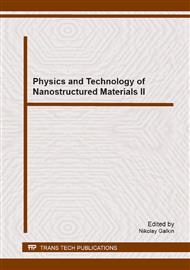[1]
U. Martinez, G. Pacchioni, Interaction of CO, CO2 and CH4 with mesoporous organosilica: Periodic DFT calculations with dispersion corrections, Microp. Mesop. Mater. 129 (2010) 62-67.
DOI: 10.1016/j.micromeso.2009.08.033
Google Scholar
[2]
F. Musso, P. Ugliengo, M. Sodupe, Do H-bond features of silica surfaces affect the H2O and NH3 adsorption? Insights from periodic B3LYP calculations, J. Phys. Chem. A 115 (2011) 11221-11228.
DOI: 10.1021/jp203988j
Google Scholar
[3]
Y.D. Glinka, S. -H. Lin, L. -P. Hwang, Y. -T. Chen, N.H. Tolk, Size effect in self-trapped exciton photoluminescence from SiO2-based nanoscale materials, Phys. Rev. B 64 (2001) 085421-1-085421-11.
DOI: 10.1103/physrevb.64.085421
Google Scholar
[4]
X. Gonze, B. Amadon, P. -M. Anglade, J. -M. Beuken, F. Bottin, P. Boulanger, F. Bruneval, D. Caliste, R. Caracas, M. Cote, T. Deutsch, L. Genovese, Ph. Ghosez, M. Giantomassi, S. Goedecker, D.R. Hamann, P. Hermet, F. Jollet, G. Jomard, S. Leroux, M. Mancini, S. Mazevet, M.J.T. Oliveira, G. Onida, Y. Pouillon, T. Rangel, G. -M. Rignanese, D. Sangalli, R. Shaltaf, M. Torrent, M.J. Verstraete, G. Zerah, J.W. Zwanziger, ABINIT: First-principles approach to material and nanosystem properties, Comput. Phys. Commun. 180 (2009).
DOI: 10.1016/j.cpc.2009.07.007
Google Scholar
[5]
M. Fuchs, M. Scheffler, Ab initio pseudopotentials for electronic structure calculations of poly-atomic systems using density-functional theory, Comput. Phys. Commun. 119 (1999) 67-98.
DOI: 10.1016/s0010-4655(98)00201-x
Google Scholar
[6]
A.N. Chibisov, M.A. Chibisova, Simulation of the atomic and electronic structures of mesoporous SiO2 containing Ti4+ and Zr4+ ions, Technical Phys. 56 (2011) 567-569.
DOI: 10.1134/s1063784211040116
Google Scholar
[7]
T.J. Lee, J.M.L. Martin, P.R. Taylor, An accurate ab initio quartic force field and vibrational frequencies for CH4 and isotopomers, J. Chem. Phys. 102 (1) (1995) 254-261.
DOI: 10.1063/1.469398
Google Scholar
[8]
L. Yu, Z. -Z. Yang, Study on structures and properties of ammonia clusters (NH3)n (n=1–5) and liquid ammonia in terms of ab initio method and atom-bond electronegativity equalization method ammonia-8P fluctuating charge potential model, J. Chem. Phys. 132 (2010).
DOI: 10.1063/1.3418567
Google Scholar
[9]
N.B. Okulik, R. Pis Diez, A.H. Jubert, Topological study of the effect of the isomorphic substitution of silicon by aluminum on the zeolite structure and its interaction with methane, J. Phys. Chem. A 107 (2003) 6225-6230.
DOI: 10.1021/jp027399t
Google Scholar


